
25 Negative SEO Case Studies That Will Shock You Into Taking Action
Look, I’ll be straight with you – negative SEO attacks are getting nastier by the day. Google Trends shows “negative SEO” searches growing over the past 24 months, and trust me, there’s a reason people are searching for this stuff more often.
Just last month, I had a client call me in a panic because their traffic had dropped off a cliff overnight. We’re talking 60% gone. Poof. When we dug into it, we found someone had blasted their site with thousands of garbage links from sketchy websites. It was like watching a digital hit job unfold in real time.
That wake-up call taught me something important: understanding these attacks isn’t some academic exercise – it’s about protecting your livelihood. These 25 real-world case studies will show you exactly how brutal negative SEO can get, and more importantly, what you can do to protect yourself.
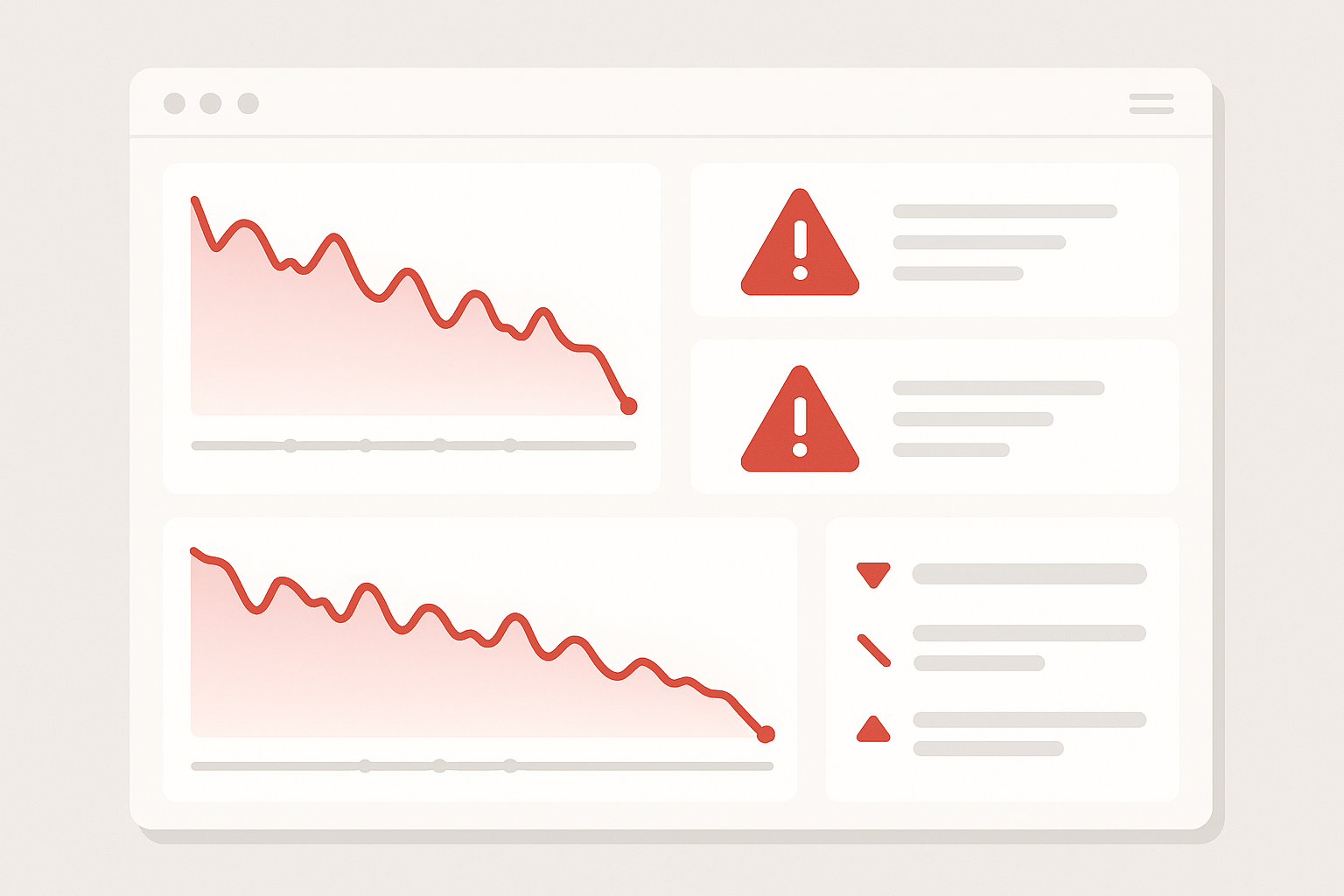
Table of Contents
-
TL;DR: The Brutal Truth
-
How to Evaluate These Attacks (Without Losing Your Mind)
-
Link-Based Attacks: The Classic Hits (Cases 1-4)
-
Content Wars: When Someone Steals Your Thunder (Cases 5-8)
-
Technical Sabotage: The Nuclear Option (Cases 9-12)
-
Local Business Nightmares (Cases 13-16)
-
Brand Assassination Attempts (Cases 17-20)
-
The Really Scary Stuff: Advanced Attacks (Cases 21-25)
-
Simple vs Complex: What You’re Really Up Against
-
Recovery Patterns: What Actually Works
-
Why You Need Professional Help (And I’m Not Just Saying That)
-
The Bottom Line
TL;DR: The Brutal Truth
Here’s what these 25 cases taught me, and what you need to know right now:
-
Negative SEO attacks can destroy 70% of your organic traffic faster than you can say “algorithm update”
-
Speed matters more than anything – catch it in the first week, and you might recover in 3 months. Miss it for a month, and you’re looking at a year of pain
-
Technical attacks are like digital dynamite – they’ll blow up your traffic overnight, but they’re actually the easiest to prevent if you know what you’re doing
-
Link spam is still the weapon of choice for digital bullies, and it’s getting more sophisticated
-
Recovery costs range from “ouch” ($1,000) to “holy crap” ($25,000+) depending on how bad things get
-
Local businesses have a giant target on their backs thanks to Google My Business vulnerabilities
-
The really scary attacks hit you from multiple angles at once, like a digital ambush
-
Trying to handle this stuff yourself is like performing surgery with a butter knife – possible, but why would you?
How to Evaluate These Attacks (Without Losing Your Mind)
Before we dive into the horror stories, you need to understand how to think about negative SEO threats. I’ve learned the hard way that not all attacks are created equal, and your response needs to match the threat level.
Here’s the thing about evaluating negative SEO attacks – you can’t just look at one metric and call it a day. Understanding what is negative SEO and its various flavors is crucial for not completely losing your mind when something goes wrong.
The most important question is always: How bad is this really? You need hard numbers – percentage drops in traffic, lost keyword positions, and actual dollar impact. I’ve seen business owners panic over a 5% traffic dip that turned out to be seasonal, and I’ve seen others shrug off 40% losses because they didn’t understand the implications.
How fast did you catch it? This is where heroes and zeros are separated. Attacks caught in the first week usually mean you’re back to normal in a few months. Let it slide for a month, and you’re in for a long, expensive ride. I’ve seen gradual attacks that mimicked natural declines fool people for months while the damage compounded.
How long will this take to fix? Simple technical issues might get resolved in weeks, but algorithmic penalties from link attacks? You’re looking at 6-12 months of grinding it out. Set your expectations accordingly, or you’ll drive yourself crazy.
Understanding SEO case study methodologies gives you the framework to analyze these situations without losing your shirt or your sanity.
|
Attack Evaluation |
“Oh Crap” Level |
“This Sucks” Level |
“We’ll Survive” Level |
|---|---|---|---|
|
Traffic Loss |
50%+ gone |
20-49% hit |
Under 20% dip |
|
Detection Time |
Took over a month to notice |
Caught it in 1-4 weeks |
Spotted it in a week |
|
Recovery Time |
6+ months of hell |
3-6 months of work |
Under 3 months |
|
Cost to Fix |
$25,000+ (gulp) |
$5,000-$25,000 |
$1,000-$5,000 |
|
Could You Prevent It? |
Nearly impossible |
Maybe with effort |
Totally preventable |
|
Attack Complexity |
Multi-pronged nightmare |
Single-vector attack |
Simple technical issue |
The cost to fix this mess includes everything – tools, services, the hours you’ll spend not sleeping, and all the revenue you’ll lose while sorting it out. A $5,000 investment in quick response might save you $50,000 in lost business. Do the math.
Could you have prevented this? Technical vulnerabilities are usually preventable if you know what you’re doing. External link spam? That requires constant vigilance and good monitoring systems.
Questions That’ll Keep You Up at Night
Do you actually know what’s happening to your site right now? I mean really know? Most businesses are flying blind without proper monitoring. You need alerts for traffic drops, ranking changes, and suspicious backlink activity. Without this stuff, you’re basically hoping nothing bad happens.
When something goes wrong, do you have the expertise to fix it? Fixing a hacked robots.txt file is different from recovering from a coordinated brand assassination campaign. Know your limits.
How much traffic loss can you actually handle? Some businesses can weather 30-40% drops for months while they fix things. Others need traffic yesterday. Be honest about your situation.
What kind of competitive battlefield are you in? High-stakes industries with big money attract nastier tactics. If there’s serious cash involved, someone might be willing to play dirty.
Link-Based Attacks: The Classic Hits
Link-based attacks are the bread and butter of negative SEO. They’re popular because they exploit Google’s core ranking factor – backlinks. These range from obvious spam blasts to sophisticated manipulation that can fool even experienced SEOs.
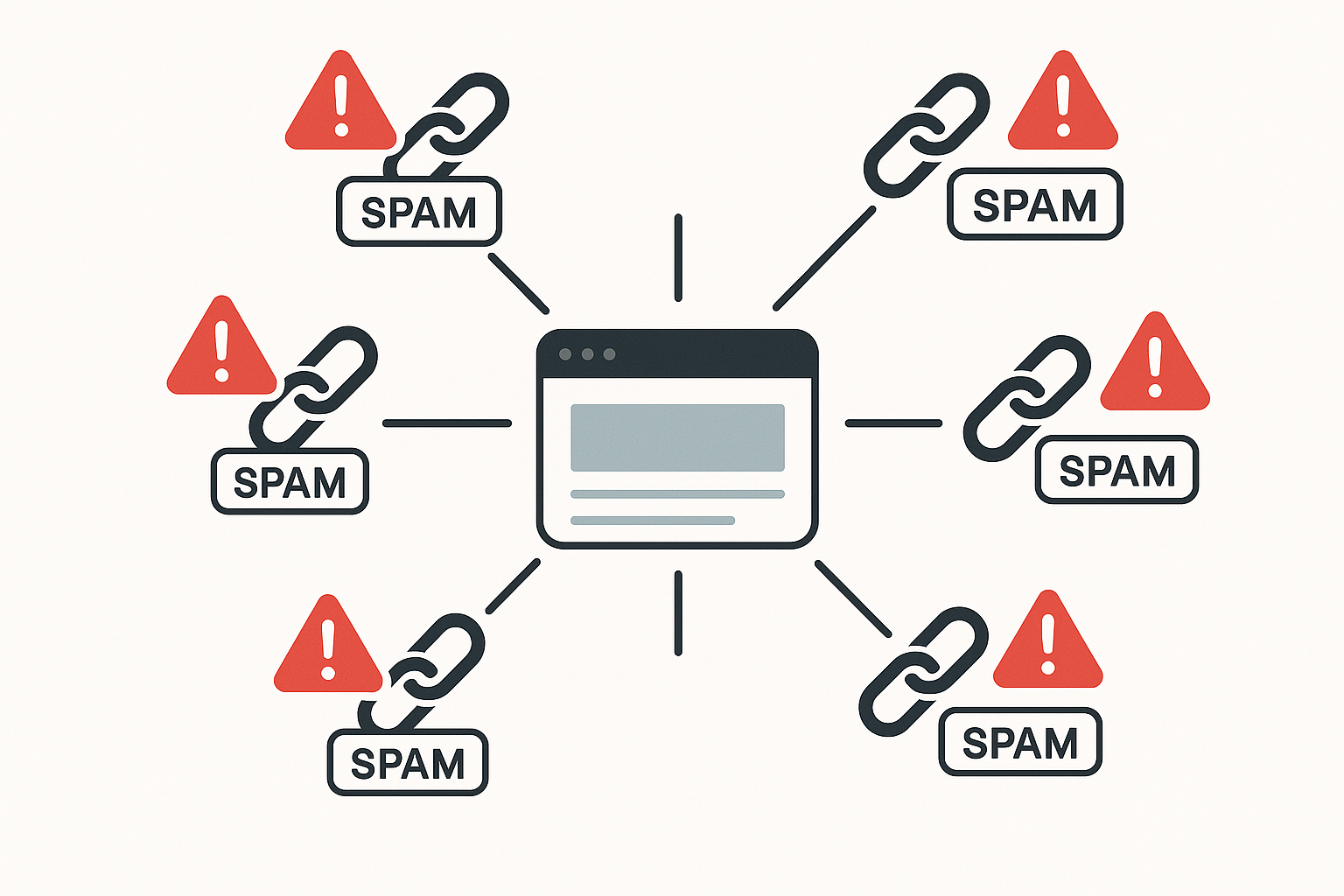
1. The Link Farm Massacre
Here’s what happened to this poor electronics retailer: Someone unleashed an army of bots that spent an entire month hammering them with garbage links. We’re talking 15,000 links from over 200 sketchy websites – the kind of sites that look like they were built in someone’s basement in 1999.
How We Caught It: Their weekly backlink monitoring lit up like a Christmas tree. Their referring domains jumped from 1,200 to 16,200 overnight. When I saw that graph, my jaw literally dropped. The average domain authority of linking sites plummeted, and suddenly 95% of their anchor text was exact match commercial terms. It was like someone had painted a giant target on their forehead.
The Cleanup Mission: We had to go through 14,847 toxic domains one by one, create a disavow file that looked like a phone book, and then play the waiting game with Google. We also reached out to any legitimate sites we could find, basically begging them to remove the links.
The Brutal Timeline: Eight months. Eight. Months. The client was calling me every week asking when things would get better. Google processes disavow files slower than molasses, and we had to rebuild their natural link profile from scratch.
Real Talk: An e-commerce site owner called me at 6 AM after noticing their backlink count had exploded overnight. Using Ahrefs, we discovered 95% of the new links came from domains with authority scores in the toilet, all using identical anchor text patterns. When legitimate link building creates uniform, low-quality patterns in compressed timeframes, you know you’re looking at an attack.
Getting your SEO ROI tracking sorted helps you understand just how much these negative SEO attacks are actually costing your business.
2. The Link Hijacking Heist
This one still makes my blood boil. Instead of creating new spam links, these attackers were smart – they redirected this law firm’s existing quality backlinks to spam sites. They were literally stealing link equity while making it look like legitimate linking patterns.
The Slow Burn: Rankings dropped 30% over several months. It was gradual enough that the client thought it was just increased competition. The attack’s subtlety meant our usual spam detection methods missed it completely.
The Recovery Nightmare: We had to rebuild relationships with every hijacked link source. Try explaining to a website owner that their link to your client now points to a gambling site. Many had no idea their links had been compromised, which made the whole process feel like digital detective work.
The Lesson: This taught me to monitor existing backlinks, not just new ones. Now I tell all my clients – if you’ve got quality backlinks, treat them like the valuable assets they are and check on them regularly.
3. Anchor Text Poisoning
Picture this: A SaaS company wakes up to find thousands of backlinks with spammy, over-optimized anchor text flooding their link profile. Their anchor text distribution went from natural to 70% exact match commercial terms overnight. Google’s unnatural linking penalty followed shortly after.
The Manual Action: Google’s penalty notice specifically called out “unnatural linking patterns.” When Google takes the time to manually penalize you, you know you’re in deep trouble. This wasn’t just an algorithmic slap – this was a human reviewer saying “nope.”
The Long Road Back: Beyond disavowing the toxic links, we had to actively build natural links with diverse anchor text to dilute the poison. We created content that naturally attracted branded and generic anchor text, basically rebuilding their entire link profile from the ground up.
Prevention Gold: Regular anchor text analysis can catch poisoning attempts before they trigger penalties. Healthy sites show diverse patterns with branded terms dominating. If your exact match anchors suddenly spike, investigate immediately.
4. The Velocity Bomb
Someone decided to nuke this online education platform with 50,000+ garbage links in 48 hours. Google’s real-time algorithms caught it immediately, and traffic dropped 60% faster than you could refresh Analytics.
The Emergency Response: We submitted an emergency disavow file and reconsideration request within 72 hours. The client was calling me every hour asking what else we could do. Sometimes the best thing is to act fast and then wait.
The Silver Lining: Four months to full recovery isn’t bad for this type of attack. The clear attack pattern made it easier for Google to distinguish between malicious activity and legitimate SEO efforts. Sometimes obvious attacks are easier to recover from than subtle ones.
The Monitoring Lesson: This case hammered home the importance of watching link velocity. Sudden spikes in backlinks, even from decent-looking sources, deserve immediate investigation. Natural link building doesn’t happen in explosive bursts.
Content Wars: When Someone Steals Your Thunder
Content-based negative SEO attacks hit you where it hurts – your expertise and authority. These include content scraping, fake reviews, meta tag manipulation, and schema poisoning. They can trigger duplicate content penalties and trash your reputation faster than you can say “original content.”
5. The Content Scraping Nightmare
This digital marketing blog was getting systematically ripped off by sophisticated scrapers who monitored their publishing schedule and republished content across multiple domains before the original even went live. Talk about adding insult to injury.
The Detection: Copyscape alerts were going off constantly, and manual searches were finding their content everywhere. The scrapers were using RSS feeds and automated monitoring to steal content within minutes of publication. It was like having digital parasites.
The DMCA Marathon: Filing takedown requests became a full-time job. Many scraping sites operated from countries where DMCA enforcement is about as effective as asking politely. We spent months playing whack-a-mole with content thieves.
The Technical Fix: We implemented canonical tags, delayed RSS feeds, and created subscriber-exclusive previews. Sometimes you have to get creative to stay ahead of the content vultures.
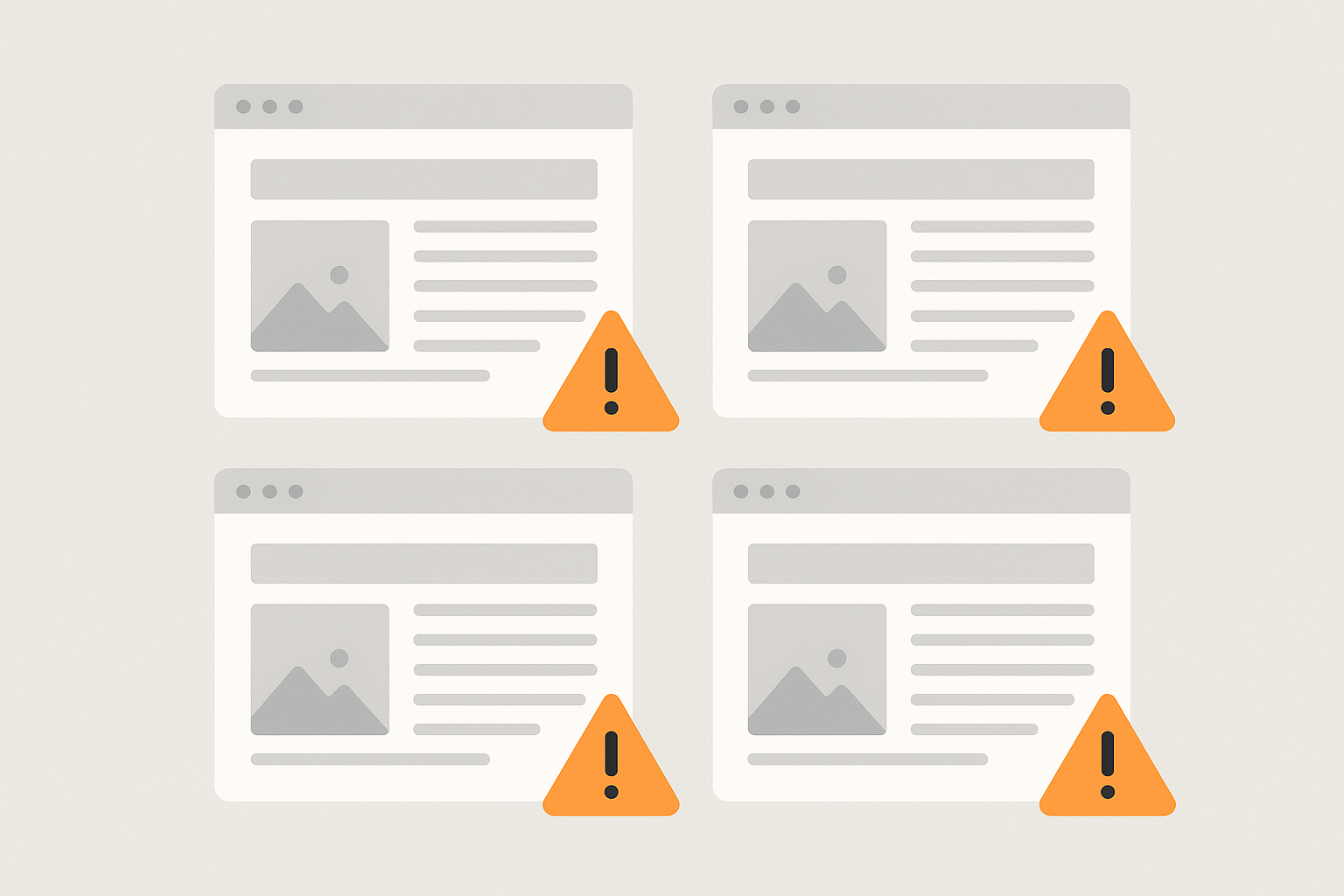
6. The Fake Review Bombing
A restaurant chain got hit with a coordinated fake review campaign across Google, Yelp, and Facebook. Their rating dropped from 4.2 to 2.1 stars, and their local search visibility fell off a cliff. Customers started calling to ask if they were still in business.
The Pattern Recognition: Similar language patterns, brand new accounts, and suspicious timing made it obvious this wasn’t organic negative feedback. Many fake accounts had no other review activity and used stock photos. The reviews all appeared within a 2-week window, which was the smoking gun.
The Platform Appeals: Each platform has different requirements for proving reviews are fake. Google was fastest to respond, Yelp’s filtering system eventually caught most of the fakes, but Facebook was like talking to a wall. The inconsistency was maddening.
The Recovery Strategy: Beyond removing fake reviews, we launched an aggressive legitimate review generation campaign. We basically had to flood the zone with real customer experiences to push the fake ones down.
7. Meta Tag Mayhem
Hackers broke into a healthcare website’s CMS and systematically changed title tags and meta descriptions to include inappropriate pharmaceutical content. The site got completely removed from search results for their own brand terms. Patients couldn’t find them online.
The Immediate Panic: SERP monitoring revealed inappropriate meta descriptions appearing in search results within hours. The healthcare site’s professional reputation was getting trashed in real time. The phone calls from confused patients started immediately.
The Security Lockdown: Two weeks of intensive work included security auditing, password changes across all accounts, two-factor authentication setup, and complete meta tag restoration from clean backups. We basically had to assume everything was compromised.
The Prevention Reality: This case showed me that regular security audits aren’t optional. Strong access controls and automated monitoring of critical on-page elements should be standard practice, not an afterthought.
Understanding negative search engine optimization tactics helps you implement security measures to prevent unauthorized changes to your critical SEO elements.
8. Schema Markup Sabotage
Attackers injected malicious schema markup that corrupted a local service business’s structured data. They lost their rich snippets and featured snippet positions that had been driving significant traffic. Google basically stopped trusting their structured data entirely.
The Structured Data Disaster: The corrupted markup caused Google to reject not just the poisoned elements, but their entire schema implementation. It was like one bad apple spoiling the whole barrel.
The Rebuild Process: Complete schema audit and clean markup implementation took a month. We had to rebuild trust with Google’s structured data systems through consistent, error-free markup. Every single piece of structured data had to be verified and revalidated.
The Monitoring Truth: Regular structured data testing caught this quickly, preventing more extensive damage. I now tell clients that automated schema monitoring should be part of routine technical SEO maintenance, not something you check once and forget.
Technical Sabotage: The Nuclear Option
Technical negative SEO attacks are like digital dynamite – they exploit website vulnerabilities to disrupt search engine crawling, indexation, and user experience. These attacks cause immediate, severe damage but are often the most preventable with proper security measures.
9. XML Sitemap Sabotage
Hackers broke into this news website’s CMS and completely trashed their XML sitemaps, stuffing them full of thousands of malicious URLs pointing to spam content. Google took one look at the corrupted sitemaps and basically said “nope” to indexing 50% of their pages.
The Indexation Disaster: Google Search Console reports showed a dramatic drop as the search engine encountered errors trying to crawl the corrupted sitemap data. Legitimate pages were getting removed from the index just because they were associated with spam URLs in the sitemap.
The Security Overhaul: Recovery meant comprehensive security measures – CMS updates, plugin audits, access control reviews, and automated backup systems for all critical SEO files. We basically had to assume everything was compromised and start fresh.
The Monitoring Gap: Six weeks to full recovery could have been shortened with automated sitemap monitoring. I now recommend daily sitemap validation checks – it takes 30 seconds and can save you months of headaches.
The Prevention Story: A SaaS company dodged this bullet by implementing automated daily sitemap checks using Google Search Console API. Their monitoring script compared current sitemap structure against a baseline, alerting administrators within 15 minutes of any unauthorized changes. When attackers tried to inject malicious URLs, the system immediately restored the clean backup and blocked the compromised admin account.
10. The Robots.txt Disaster
Someone changed this e-commerce fashion site’s robots.txt file to block all search engine crawlers. Within 72 hours, their product pages started disappearing from Google. Traffic went to zero faster than you could say “Disallow: /”.
The Traffic Cliff: When organic traffic drops to literally zero in three days, you know something’s seriously wrong. The attack was impossible to miss, but the potential for catastrophic damage was terrifying. One simple file change nearly destroyed their entire online presence.
The Simple Fix, Long Recovery: Fixing the robots.txt took 5 minutes. Getting Google to trust them again took 3 weeks. We submitted crawl requests and monitored reindexation, but Google moves cautiously when reindexing previously blocked content.
The Security Lesson: File permission audits, automated robots.txt monitoring, and access logging should be standard practice. The robots.txt file is a critical SEO asset that needs protection like any other valuable business resource.
Comprehensive GA4 audit processes help you spot traffic anomalies that might indicate technical negative SEO attacks before they completely tank your visibility.
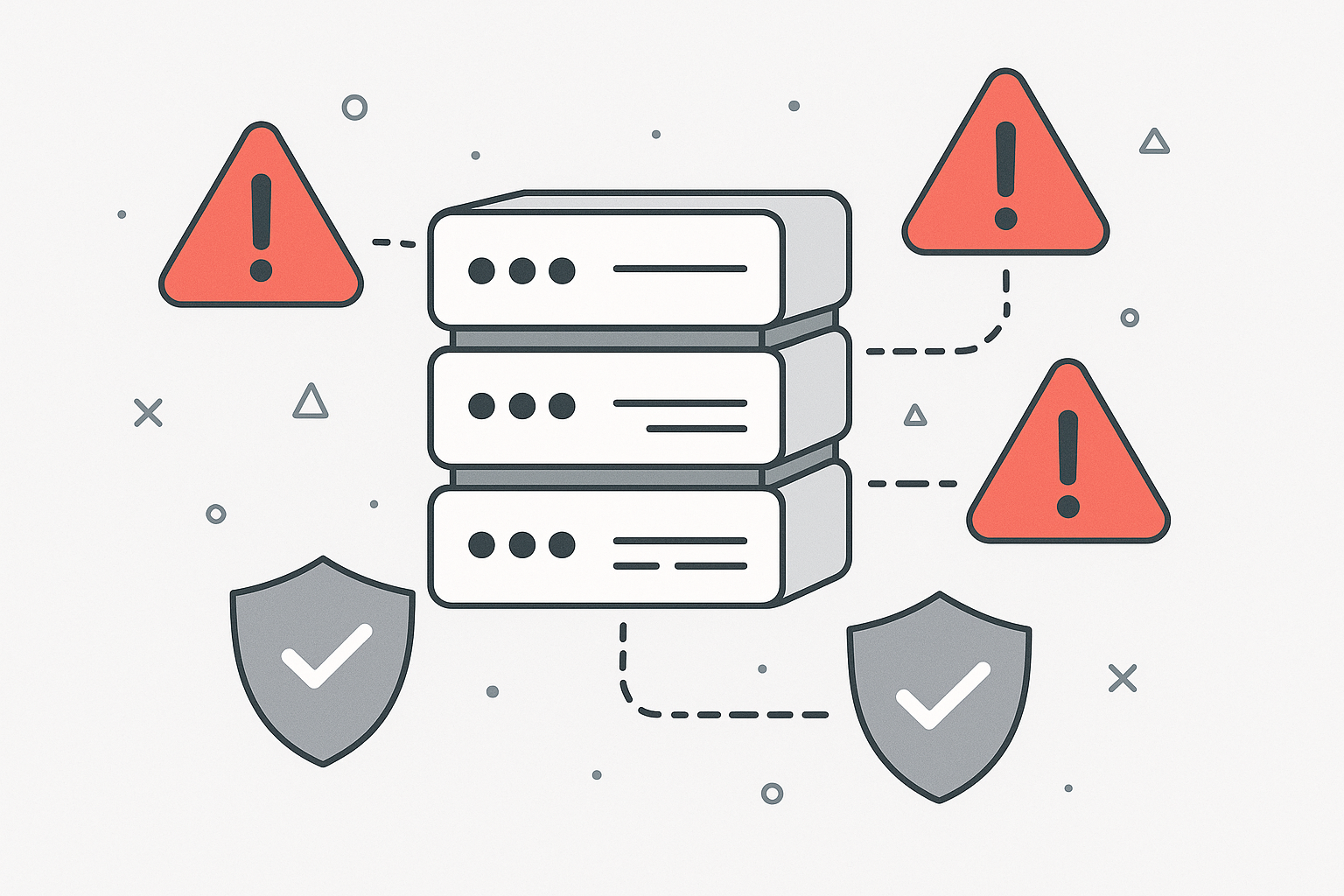
11. The Performance Attack
Coordinated bot traffic specifically targeted this travel booking website during their busiest periods, causing server slowdowns that destroyed their Core Web Vitals scores. Google’s page experience update turned performance problems into ranking penalties.
The Algorithm Connection: The 35% ranking drop correlated directly with poor Core Web Vitals performance. Google’s page experience update made site speed a ranking factor, so performance attacks became SEO weapons. The timing during peak booking periods was diabolical.
The Technical Response: CDN implementation, bot blocking, and server optimization took 2 months to fully address. The attack’s timing during peak business periods maximized damage and complicated our response efforts. We were basically trying to fix a plane while it was flying.
The Integrated Monitoring: This case taught me that server performance, user experience metrics, and SEO performance need to be monitored together. Performance-based attacks are becoming more common as Core Web Vitals gain importance.
12. The Malware Injection
Hidden malware injection triggered Google Safe Browsing warnings, resulting in complete removal from search results with big red warnings displayed to users. The small business lost both search visibility and direct traffic during the 4-week nightmare.
The Reputation Damage: Beyond SEO impact, the malware warnings destroyed user trust and brand reputation. Customers were afraid to visit the site even after the malware was removed. The psychological damage lasted longer than the technical issues.
The Professional Cleanup: Malware removal required security specialists, comprehensive site auditing, and detailed documentation for Google’s review process. We had to prove complete malware removal before search presence could be restored. Google doesn’t mess around with security issues.
The Prevention ROI: This case showed me that proactive security measures cost way less than recovery. Security monitoring, regular updates, and access controls would have prevented this entire mess for a fraction of the recovery cost.
Local Business Nightmares
Local businesses face unique negative SEO attacks through Google My Business manipulation, fake citation campaigns, location spoofing, and review platform abuse. These attacks can devastate local search visibility and directly impact foot traffic and phone calls.
13. Google My Business Hijacking
Attackers successfully claimed this dental practice’s Google My Business listing and changed contact information, hours, and location details. Patients were calling wrong numbers and showing up at incorrect addresses. It was chaos.
The Real-World Impact: Patients reported calling incorrect phone numbers and visiting wrong addresses, creating real-world consequences beyond digital metrics. The confusion damaged patient relationships and the practice’s reputation in the community.
The Verification Hell: Google’s verification process required extensive documentation to prove legitimate business ownership. The 8-week recovery timeline reflected Google’s cautious approach to GMB ownership disputes. Every day of delay meant lost patients and revenue.
The Security Basics: Regular GMB monitoring, strong account security, and updated business verification documents can prevent hijacking attempts. Two-factor authentication and access logging are essential for multi-location businesses.
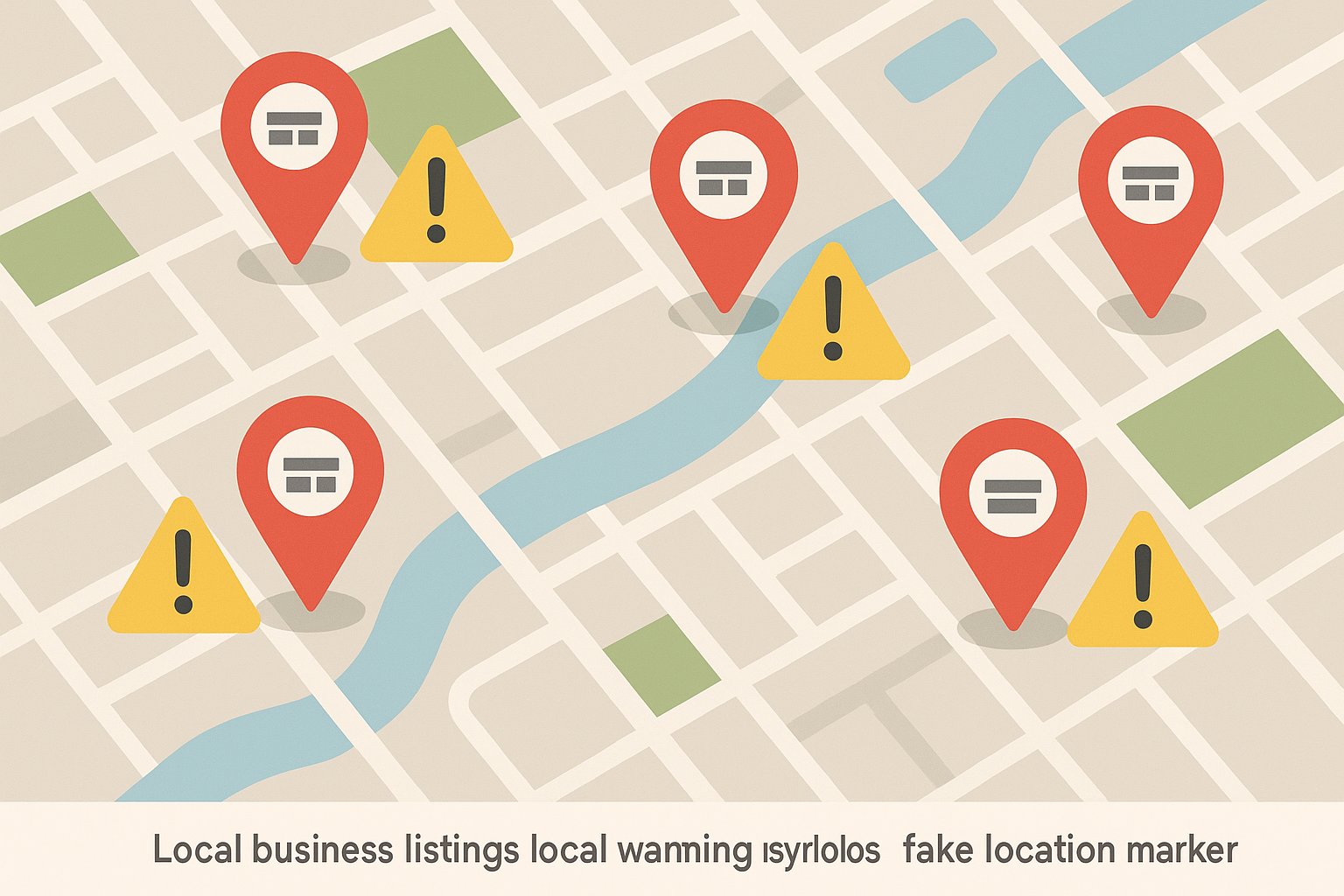
14. The Citation Pollution Campaign
Hundreds of fake local citations with incorrect NAP (Name, Address, Phone) information created massive inconsistencies across the web. This plumbing company’s local rankings dropped 50% as search engines couldn’t figure out their actual business information.
The Data Chaos: Local SEO algorithms rely heavily on consistent NAP information across multiple sources. The fake citations created conflicting signals that undermined the business’s local authority and trustworthiness in Google’s eyes.
The Cleanup Marathon: The 5-month citation cleanup required identifying fake listings across hundreds of directories, submitting removal requests, and creating accurate citations to dilute the fake data. It was like digital archaeology.
The Monitoring Reality: Regular citation auditing and NAP consistency monitoring can catch fake citation campaigns before they tank your local rankings. Automated tools can track citation creation and flag inconsistencies quickly.
15. Location Spoofing Scam
Fake business listings created in this HVAC contractor’s service areas diluted their local authority and created confusion in local search results. The fake locations appeared legitimate with stolen photos and fabricated reviews.
The Authority Dilution: Multiple fake locations competing for the same keywords reduced the legitimate business’s local search visibility and click-through rates. Customers couldn’t distinguish between legitimate and fake listings.
The Detective Work: Competitive analysis and local market monitoring revealed suspicious new competitors with identical services and unrealistic review patterns. The fake listings often used stock photos and generic business descriptions.
The Reporting Process: Reporting fake listings to Google and local directories required detailed evidence of fraudulent activity. The 4-month timeline reflected the challenge of proving listings were fake rather than legitimate competitors.
16. The Competitor Review Boost
Instead of attacking the auto repair shop directly, attackers created fake positive reviews for fabricated competitor businesses, making the legitimate business appear less credible by comparison.
The Indirect Attack: Customers comparing local options saw fake competitors with perfect 5-star ratings and glowing reviews, making the legitimate business’s authentic 4.2-star rating seem inferior. The psychological impact was devastating.
The Authentic Response: The 6-month recovery focused on generating authentic reviews and building genuine local authority rather than trying to remove fake competitors. This approach proved more sustainable and effective long-term.
The Strategic Shift: Building authentic review generation systems and focusing on genuine customer satisfaction provided better protection against review manipulation than reactive responses to fake competitors.
|
Local SEO Attack Type |
How to Spot It |
Recovery Time |
Prevention Cost |
|---|---|---|---|
|
GMB Hijacking |
Account notifications, customer complaints |
6-12 weeks |
$200-500/month monitoring |
|
Fake Citations |
NAP consistency audits |
4-6 months |
$300-800/month management |
|
Location Spoofing |
Competitive monitoring |
3-5 months |
$400-1000/month surveillance |
|
Review Manipulation |
Review pattern analysis |
6-12 months |
$500-1500/month reputation management |
Brand Assassination Attempts
Brand-focused negative SEO attacks target your company’s reputation and online presence through impersonation campaigns, negative PR, social media hijacking, and search results manipulation. These attacks damage brand trust and reduce direct navigation traffic.
17. The Brand Impersonation Campaign
Fake social media profiles and websites impersonating this luxury watch retailer created massive brand confusion and diverted potential customers to competitor sites or fraudulent operations. Customers couldn’t tell what was real anymore.
The Customer Confusion: Brand confusion resulted in lost direct navigation traffic as customers couldn’t distinguish between legitimate and fake brand presences. Customer service inquiries about fake promotions and products skyrocketed.
The Legal Battle: The 3-month recovery required coordinating legal action, platform reporting, and brand protection measures across multiple jurisdictions. Trademark enforcement became a critical component of the response strategy.
The Monitoring Systems: Comprehensive brand monitoring tools detected unauthorized brand usage across social media, domain registrations, and advertising platforms. Early detection enabled faster response and reduced customer confusion.
18. The Negative PR Blitz
False negative stories published across multiple platforms created a sustained negative narrative about this software company. Brand-related search traffic dropped 20% as customer confidence and trust eroded.
The SEO Impact: Negative content ranking for brand terms reduced click-through rates and conversion rates for branded searches. The coordinated nature made the false stories appear more credible and newsworthy to both search engines and users.
The PR Recovery: The 8-month recovery campaign required professional PR services, positive content creation, and relationship building with legitimate media outlets. Restoring brand reputation took significantly longer than addressing technical SEO issues.
The Content Strategy: Creating authoritative, positive content to outrank negative stories required sustained effort and strategic content planning. The company had to become more proactive about brand storytelling and thought leadership.
Understanding negative SEO tactics helps businesses prepare comprehensive brand protection strategies that address both technical and reputational vulnerabilities.
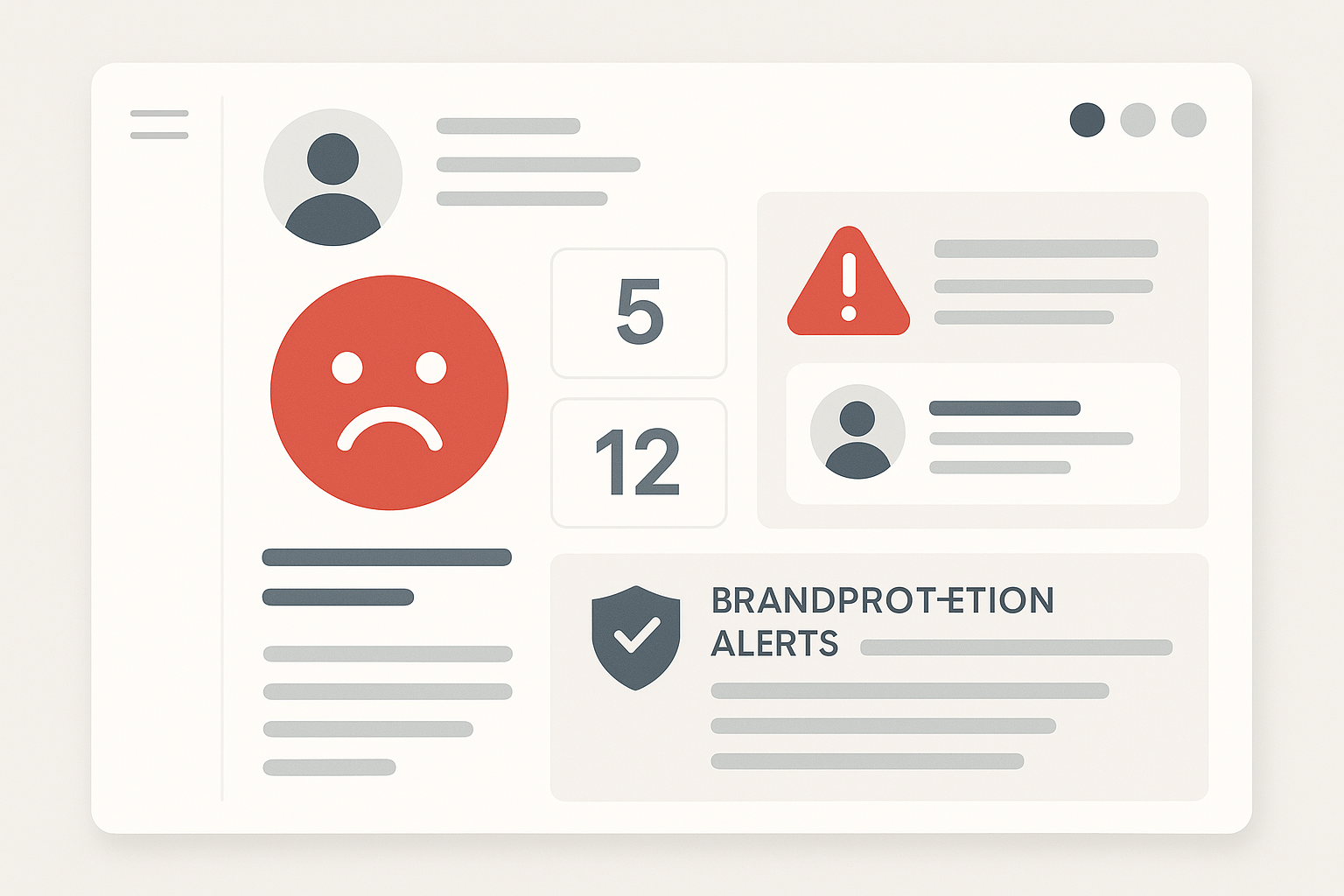
19. Social Media Account Takeover
Compromised official social media accounts posted inappropriate content that damaged this restaurant chain’s brand reputation and reduced social signals that support SEO performance. The crisis management nightmare lasted weeks.
The Crisis Escalation: The 6-week recovery required immediate account recovery, content cleanup, crisis communication with customers, and rebuilding social media presence. The inappropriate content was screenshot and shared, extending damage beyond the initial posts.
The Security Overhaul: Two-factor authentication, access controls, and social media monitoring became essential components of brand protection. Regular security audits of all social media accounts prevented repeat incidents.
The Trust Rebuild: Rebuilding social media trust required consistent, authentic engagement and transparent communication about the security breach. The restaurant used the incident to demonstrate improved security and customer care.
20. Search Results Hijacking
Creating negative content specifically designed to rank for this financial services firm’s brand terms pushed positive content down in search results and damaged brand perception for potential customers researching the company.
The Content Warfare : The negative content used SEO best practices to achieve high rankings, making it difficult to outrank through traditional methods. The attackers understood search algorithms and exploited them effectively.
The Positive Content Blitz: The 4-month SERP optimization campaign required creating high-quality, authoritative content that could outrank the negative material. This included thought leadership articles, case studies, and multimedia content.
The Long-term Defense: Building a strong content foundation and maintaining active brand management became essential for preventing future SERP manipulation attempts. Regular brand SERP monitoring enabled quick response to new threats.
Developing effective high-impact blog topics becomes crucial for creating positive content that can outrank negative SEO attacks targeting your brand terms.
The Really Scary Stuff: Advanced Attacks
The most sophisticated negative SEO attacks combine multiple vectors simultaneously, exploit algorithm updates, gather competitive intelligence, compromise supply chains, and use AI-generated content flooding. These advanced persistent threats require comprehensive defense strategies and professional expertise.
21. The Multi-Vector Nightmare
This e-learning platform got hit with everything at once – 25,000+ toxic backlinks, 500+ duplicate pages, server overloads, and malicious code injection. Traffic dropped 70% as the attacks compounded each other’s damage.
The Perfect Storm: Individual attack components seemed manageable in isolation, which masked the coordinated nature. Link spam looked moderate, content duplication appeared routine, and technical issues seemed operational. Only comprehensive analysis revealed the coordinated assault.
The Recovery Phases: Twelve months of systematic recovery through emergency stabilization (months 1-3), systematic remediation (months 4-6), and defensive strengthening (months 7-12). Each phase built upon previous work while maintaining vigilance against ongoing attacks.
The Resource Reality: This attack type demands significant technical expertise, financial resources, and sustained organizational attention. The complexity requires professional SEO services and dedicated security resources that most businesses don’t have in-house.
The Detection Challenge: An e-learning platform initially dismissed individual warning signs – moderate link spam seemed manageable, content duplication appeared routine, and server issues looked operational. Only when traffic dropped 70% did comprehensive analysis reveal the coordinated attack. The lesson: seemingly unrelated SEO issues occurring simultaneously often indicate sophisticated campaigns requiring immediate professional intervention.
22. Algorithm Exploitation Attack
This news website got caught in an algorithm update designed to target low-quality content, but attackers exploited the update’s criteria to trigger false positive penalties through strategic content manipulation.
The Timing Precision: Attackers demonstrated sophisticated understanding of Google’s algorithm updates and used this knowledge to make legitimate content appear to violate quality guidelines. The timing with the algorithm update was no coincidence.
The Compliance Nightmare: The 6-month recovery required aligning content with algorithm requirements while proving the manipulation was external. This involved comprehensive content audits and quality improvements while documenting the attack.
The Algorithm Defense: Understanding algorithm updates and their potential exploitation became essential for preventing similar attacks. Staying informed about algorithm changes helps identify potential vulnerabilities before they’re exploited.
23. Competitive Intelligence Warfare
This project management SaaS faced systematic analysis and exploitation of SEO weaknesses, resulting in gradual erosion of competitive advantages and keyword positions over 9 months. It was death by a thousand cuts.
The Systematic Approach: Attackers identified technical vulnerabilities, content gaps, and link building opportunities, then systematically exploited these weaknesses while strengthening their own competitive positions.
The Defensive Strategy: Recovery required comprehensive SEO auditing, competitive analysis, and strategic improvements to address identified weaknesses. The focus shifted from attacking competitors to strengthening our own vulnerabilities.
The Intelligence Protection: Protecting competitive intelligence and regularly auditing for vulnerabilities became essential. Understanding your own weaknesses prevents their exploitation by sophisticated competitors.

24. Supply Chain SEO Attack
Compromised third-party services and plugins injected negative SEO elements across this e-commerce marketplace’s site functions, creating widespread technical SEO issues that were difficult to trace and resolve.
The Hidden Threat: The attack highlighted how third-party security vulnerabilities can become SEO liabilities. Compromised plugins, themes, and services introduced vulnerabilities that attackers exploited for negative SEO purposes.
The Vendor Audit: The 5-month recovery required comprehensive auditing of all third-party integrations, security assessments, and systematic replacement of compromised services. Every plugin and service had to be treated as potentially compromised.
The Supply Chain Defense: Regular vendor security assessments, access controls, and monitoring of third-party integrations became essential components of comprehensive SEO security strategies.
25. AI-Generated Content Flooding
Thousands of AI-generated low-quality pages targeting this digital marketing agency’s keywords created SERP dilution and reduced click-through rates for target keywords. The content was sophisticated enough to avoid obvious spam detection.
The Content Pollution: The AI-generated content was sophisticated enough to avoid obvious spam detection while still diluting search results and confusing topical authority signals. It was like sophisticated noise designed to drown out legitimate content.
The Authority Response: The 7-month recovery required establishing stronger topical authority through high-quality content creation, expert authorship, and comprehensive topic coverage that clearly outranked AI-generated content.
The Content Strategy: Building sustainable competitive advantages through authentic expertise and comprehensive content strategies became essential for competing against AI-generated content flooding.
This negative SEO case study demonstrates how modern attacks leverage artificial intelligence to create sophisticated content pollution campaigns that require equally sophisticated defense strategies.
Simple vs Complex: What You’re Really Up Against
Here’s the thing about negative SEO attacks – they fall into two camps: the obvious ones that hit like a sledgehammer, and the sneaky ones that slowly poison your rankings over months.
The Sledgehammer Attacks: Toxic Link Farms
The toxic link farm attack was textbook simple negative SEO. Bots created obvious spam signals through 200+ garbage domains with clear red flags: paper-thin content, massive outbound link ratios, completely unrelated anchor text, and geographic clustering in known spam havens.
Why They’re Easy to Spot: The attack’s amateur nature made detection straightforward once you knew what to look for. Weekly backlink monitoring immediately revealed the jump from 1,200 to 16,200 referring domains. The quality drop was unmistakable – like someone had dumped a truck full of garbage on your front lawn.
The Predictable Recovery: Simple negative SEO attacks follow established playbooks. Comprehensive backlink audit, disavow file creation, manual outreach, and reconsideration request – we’ve done this dance before. Progress is measurable and recovery timelines are predictable.
The Prevention Reality: Simple attacks are often preventable through basic monitoring. Automated alerts for sudden backlink spikes, domain authority changes, and anchor text distribution shifts can catch these attacks within days rather than months.
The Poison Attacks: Multi-Vector Nightmares
The e-learning platform attack showcased what keeps me up at night. Simultaneous execution across link building (25,000+ diverse toxic backlinks), content theft (500+ duplicate pages across 50+ domains), and technical vectors (server attacks, code injection) created damage that was nearly impossible to diagnose initially.
Why They’re Terrifying: Individual components looked manageable in isolation, masking the coordinated nature. Link spam seemed moderate, content duplication appeared routine, and technical issues looked operational. Only when traffic dropped 70% did we realize we were dealing with a coordinated digital assault.
The Recovery Hell: Twelve months of phase-based recovery – emergency stabilization, systematic remediation, and defensive strengthening. Each phase demanded different expertise while maintaining constant vigilance against ongoing attacks. It was like performing surgery while being shot at.
The Resource Reality: Complex attacks require professional expertise, serious financial investment, and sustained organizational attention. The technical knowledge needed to address multiple attack vectors simultaneously exceeds what most businesses can handle internally.
Attack Evolution: Getting Nastier
Modern negative SEO attacks show increasing sophistication in timing, targeting, and execution. Early attacks relied on obvious spam signals that were easy to detect but also easy to dismiss. Current attacks demonstrate understanding of search algorithms, competitive analysis, and business impact optimization.
Timing Gets Smarter: Advanced attacks coordinate with algorithm updates, seasonal business cycles, and competitive activities to maximize damage while minimizing detection. They hit when you’re most vulnerable and least likely to notice.
Targeting Gets Precise: Rather than spray-and-pray approaches, sophisticated campaigns target specific vulnerabilities, competitive advantages, and business-critical keywords. This precision makes attacks more effective while using fewer resources.
Execution Gets Subtle: Modern attacks mimic natural negative trends, making them harder to distinguish from legitimate competitive pressure or algorithm changes. This subtlety delays detection and complicates recovery efforts.
Recovery Patterns: What Actually Works
After analyzing these 25 cases, clear patterns emerge about what determines recovery success. Speed matters more than sophistication, resources matter more than good intentions, and professional help matters more than DIY heroics.
The Speed Factor
Lightning Fast Detection (0-7 days) happened in cases with obvious symptoms, automated monitoring, or established alert systems. Cases 7, 10, 12, and 19 benefited from clear indicators like complete traffic loss, inappropriate content, or security warnings.
The businesses that caught attacks immediately had comprehensive monitoring infrastructure, regular auditing procedures, and clear escalation protocols. They consistently detected attacks faster and recovered more quickly.
Moderate Detection (1-4 weeks) characterized cases with gradual onset or subtle symptoms. Cases 3, 4, 9, 11, 13, 17, 20, and 24 required active monitoring and analysis to identify attack patterns.
Slow Detection (1+ months) typically resulted from sophisticated attacks designed to mimic natural trends. Cases 1, 2, 5, 6, 8, 14, 15, 16, 18, 21, 22, 23, and 25 demonstrated how gradual attacks cause significant damage before detection.
Recovery Timeline Reality Check
Quick Recovery (under 3 months) correlated with simple attack vectors, immediate action, and technical fixes. Cases 7, 8, 10, 12, 17, and 19 showed that rapid response to straightforward attacks minimizes long-term business impact.
Standard Recovery (3-6 months) required systematic approaches, adequate resources, and single-vector focus. Cases 2, 5, 9, 11, 13, 15, 20, 22, and 24 demonstrated typical recovery timeframes for moderate complexity attacks.
Extended Recovery (6+ months) resulted from complex attacks, algorithmic penalties, or reputation damage. Cases 1, 3, 4, 6, 14, 16, 18, 21, 23, and 25 required significant resource commitment and long-term strategic approaches.
The Money Talk
Budget Recovery ($1,000-$5,000) typically involved technical fixes and basic security measures. These cases showed high ROI for preventive investments and rapid response capabilities.
Serious Investment ($5,000-$25,000) required professional services, specialized tools, and sustained effort. The investment was typically justified by traffic protection and competitive advantage maintenance.
Major Investment ($25,000+) involved extensive remediation, legal action, or comprehensive rebuilding efforts. These cases required executive approval and represented major business decisions about digital asset protection.

Why You Need Professional Help (And I’m Not Just Saying That)
Look, I’ve seen enough businesses try to handle negative SEO attacks themselves to know it rarely ends well. The Marketing Agency’s data-driven approach positions them uniquely to provide comprehensive protection through advanced monitoring, rapid response capabilities, and integrated digital marketing support during recovery.
The Monitoring You Actually Need
The Marketing Agency’s scientific approach to market analysis enables detection of subtle negative SEO attacks before they cause significant damage. Their methodology focuses on identifying gaps that most agencies miss, making them particularly effective at spotting sophisticated attack patterns that mimic natural competitive pressure.
The Real Monitoring Systems: Their data-driven approach implements comprehensive monitoring across backlink profiles, technical SEO elements, content duplication, and competitive positioning. This multi-layered monitoring catches attacks at various stages and attack vectors.
Technical Fortification That Works: With emphasis on performance and measurable ROI, The Marketing Agency implements robust technical defenses including regular security audits, automated backup systems for critical SEO elements, advanced server monitoring, and comprehensive site architecture reviews.
Competitive Intelligence: Their scientific methodology includes systematic competitive analysis that can identify potential attack sources and predict likely attack vectors based on competitive dynamics and industry patterns.
When Attacks Hit, Speed Matters
When attacks occur, The Marketing Agency’s systematic approach ensures recovery efforts are based on concrete data rather than panicked guesswork. Their proven track record with complex digital marketing challenges translates directly to crisis response capabilities.
Data-Driven Recovery: Immediate comprehensive audits using multiple data sources, prioritized recovery roadmaps based on impact analysis, continuous monitoring and adjustment of recovery strategies, and transparent reporting on recovery progress and metrics.
The Traffic Bridge: Unlike SEO-only agencies, The Marketing Agency’s comprehensive service offering (PPC, email marketing, inbound marketing) provides alternative traffic sources during recovery periods, minimizing business impact while organic recovery progresses.
Professional Expertise That Counts: Their team’s experience with sophisticated digital marketing challenges means they understand the technical, strategic, and business implications of attacks. This expertise accelerates recovery and prevents common mistakes that extend recovery timelines.
Their comprehensive approach to SEO content tools ensures businesses have the right technology stack to detect and respond to threats effectively.
Long-Term Protection That Evolves
The Marketing Agency’s focus on strategies that “thrive on data and science” rather than gambling means their protection evolves with emerging threats. Their systematic approach builds sustainable competitive advantages.
Scalable Protection Systems: AI-powered anomaly detection for early attack identification, competitive intelligence gathering to anticipate potential attacks, regular vulnerability assessments and security updates, and comprehensive documentation and playbooks for rapid response.
ROI-Focused Investment: With service pricing ranging from $500-$10,000+ monthly depending on complexity, The Marketing Agency tailors protection to match business risk tolerance and budget constraints. Their focus on measurable performance ensures protection investments deliver quantifiable value.
Business Integration: Their philosophy that “your business shouldn’t gamble on marketing” applies directly to protection. Rather than hoping attacks won’t happen or attempting amateur remediation, businesses need proven, data-driven strategies from experienced professionals.
Why DIY Usually Fails
The case studies reveal that businesses attempting in-house response often face extended recovery periods, higher total costs from trial-and-error approaches, ongoing vulnerability to repeat attacks, and lost revenue during extended recovery phases.
The Expertise Gap: Complex attacks require specialized knowledge that most businesses don’t possess internally. Professional services provide immediate access to expertise that would take years to develop in-house.
Tool Access: Professional SEO services maintain subscriptions to multiple premium monitoring and analysis tools, providing comprehensive coverage that would be cost-prohibitive for individual businesses to maintain independently.
Response Speed: Established response procedures and dedicated resources enable faster attack identification and remediation. The difference between 7-day and 30-day detection can mean the difference between 3-month and 12-month recovery timelines.
Ongoing Protection: Professional services provide continuous monitoring and threat assessment, adapting protection strategies as attack methods evolve. This ongoing vigilance prevents repeat attacks and identifies emerging threats.
This negative SEO case study analysis demonstrates that professional protection services consistently deliver better outcomes than DIY approaches, making them essential for businesses serious about protecting their digital assets.
Understanding the differences between Ahrefs vs SEMrush helps businesses choose the right monitoring tools for detecting attacks early.
Ready to protect your business from attacks? Contact The Marketing Agency today to discuss comprehensive SEO protection strategies tailored to your business needs and risk profile.
The Bottom Line
After walking through these 25 horror stories, here’s what keeps me up at night: sophisticated attacks are becoming more common, more damaging, and harder to detect. The evolution from simple link spam to multi-vector campaigns targeting technical vulnerabilities, brand reputation, and competitive positioning shows that protection isn’t optional anymore – it’s essential for survival.
The data tells a clear story. Detection speed trumps attack sophistication every time – catch it in the first week and you’re looking at 3 months of recovery. Miss it for a month, and you’re in for over a year of pain. Technical vulnerabilities create the most severe immediate damage, but they’re often the easiest to prevent if you know what you’re doing.
Here’s the brutal truth: the businesses that recovered fastest and most completely weren’t the lucky ones – they were the prepared ones. They had comprehensive monitoring systems, rapid response capabilities, professional expertise on speed dial, and integrated digital marketing strategies that provided alternative traffic sources during recovery.
These aren’t nice-to-have luxuries – they’re business necessities in today’s digital battlefield where your competitors might be willing to use any means necessary to gain market advantage.
Look, I’ve seen what happens when businesses try to handle this stuff themselves. Extended recovery periods, higher costs from trial-and-error approaches, ongoing vulnerability to repeat attacks, and lost revenue during months of fumbling around in the dark. The complexity of modern attacks, combined with the high stakes of organic traffic loss, makes professional protection services a sound business investment rather than an optional expense.
The question isn’t whether you’ll be targeted – it’s whether you’ll be ready when it happens. Don’t wait until you’re the one calling me at 2 AM in a panic, watching your traffic disappear while your competitors celebrate.
Implementing effective Ahrefs alternatives provides cost-effective monitoring solutions for businesses looking to detect attacks without premium tool investments.




